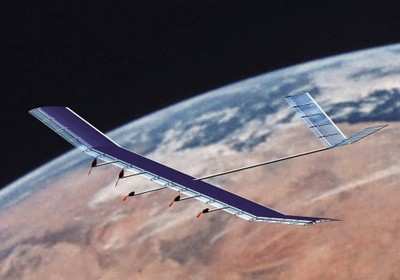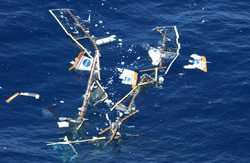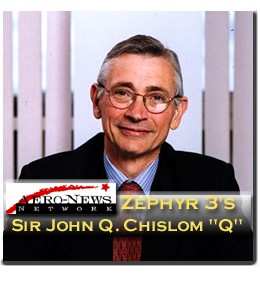Woomera Launches A British UAV, Built By The Real "Q"
A trickle of news reports worldwide indicates that an odd
British unmanned spyplane, the Zephyr 3, is flying in remote
Woomera, South Australia. The project is shrouded by a cloak of
secrecy, even though many significant features of the aircraft have
been revealed. It is likely that the machine is destined for covert
or clandestine undertakings, once testing is complete.

The Zephyr 3 has a 40-foot wingspan but weighs only 26.5 pounds,
thanks to ultralightweight composite materials and painstaking
design. It is a spanloader, an aircraft designed to bear its loads
evenly across a long wing, although unlike previous solar-powered
spanloaders, it does have a large, delicate V-tail at the end of a
stalky boom, for stability in the thin atmosphere. It is powered by
solar cells and is meant to be a stepping stone on the way to an
air vehicle that would sustain flight permanently by using hydrogen
fuel cells to store energy during periods without sunlight.
In its 2003 iteration that was shown to the press, the black
plane had five electric motors, and reportedly the new version
still does. Each motor has an output of 1 kilowatt; that power is
expressed through unusually-shaped black propellers that are
optimized for the thin air of the high stratosphere. The inner wing
panels are set level and the outer ones have fixed dihedral;
they're constructed predominantly of carbon fiber.

The reason that we know some of these details despite the 2005
news blackout is that in 2003, Zephyr 3 was being a bit more
publicized than it is now, as part of the QinetiQ1 high-altitude
manned balloon attempt, which was spoiled by a torn balloon
envelope (it may go this summer, but probably without Zephyr 3).
For example, the plane's chief designer, Chris Kelleher, spoke with
the BBC, which was also allowed to photograph the plane -- then.
But now, the guardians of Zephyr have since become much more
close-mouthed -- which may indicate that its manufacturer has
secured a somewhat publicity-shy customer for the innovative,
spindly contraption. Now, the UK MOD admits that Zephyr exists, and
that it will fly in the Woomera, South Australia, prohibited area,
but will not comment on any details.
 The unmanned craft will reportedly
climb to 132,000 feet, which would be a world record -- but the
British scientists behind it say that they may let the record go
unclaimed, in order to preserve the secrecy of -- well, whatever it
is they are up to in the Outback. The highest altitude a similar
solar UAV has achieved is 96,000 feet, a record for non-rocket
craft set in 2001 by the experimental NASA/DARPA Helios project, a
similar solar spanloader that could be configured with 14
powerplants for high-altitude performance (as in 2001), or ten for
long endurance (as in 2003).
The unmanned craft will reportedly
climb to 132,000 feet, which would be a world record -- but the
British scientists behind it say that they may let the record go
unclaimed, in order to preserve the secrecy of -- well, whatever it
is they are up to in the Outback. The highest altitude a similar
solar UAV has achieved is 96,000 feet, a record for non-rocket
craft set in 2001 by the experimental NASA/DARPA Helios project, a
similar solar spanloader that could be configured with 14
powerplants for high-altitude performance (as in 2001), or ten for
long endurance (as in 2003).
The conditions at the altitudes reached by Helios, and to which
Zephyr expects to go, are very harsh. The ambient temperature is
extremely low. But there is so little atmosphere to shield the
machine from the sun's rays that the solar panels risk overheating,
and the carbon fiber structure must be protected from thermal and
ultraviolet damage.
 To get to that height the Zephyr 3
will almost certainly be launched from an intermediate altitude by
some other air vehicle, probably a helium balloon. One reason is
that the lightly-constructed machine, optimized for flying in the
ultra-thin air at six-figure altitudes, is extremely vulnerable to
gust overloads in the thicker air down low. That same weakness
caused the loss of the Helios 03 high-endurance prototype off
Hawaii in June 2003, on only its second test flight; in normal
flight, the wing takes on a bit of smiley-face bow, but the Helios
wing bent back on itself with a dihedral of over thirty feet (!)
before breaking up (photo sequence). NASA's accident report blamed it on the
impossibility of predicting the instability that turbulence caused.
Certainly the Britons will have absorbed this NASA report and taken
it to heart before they commit Zephyr 3 to the heavens.
To get to that height the Zephyr 3
will almost certainly be launched from an intermediate altitude by
some other air vehicle, probably a helium balloon. One reason is
that the lightly-constructed machine, optimized for flying in the
ultra-thin air at six-figure altitudes, is extremely vulnerable to
gust overloads in the thicker air down low. That same weakness
caused the loss of the Helios 03 high-endurance prototype off
Hawaii in June 2003, on only its second test flight; in normal
flight, the wing takes on a bit of smiley-face bow, but the Helios
wing bent back on itself with a dihedral of over thirty feet (!)
before breaking up (photo sequence). NASA's accident report blamed it on the
impossibility of predicting the instability that turbulence caused.
Certainly the Britons will have absorbed this NASA report and taken
it to heart before they commit Zephyr 3 to the heavens.
There is no word on what the MOD's purpose for the aircraft is,
but that doesn't stop people from speculating. The most typical
uses for such high-flying craft are reconnaissance and
surveillance, or radio relay. The British special operations forces
have been known to use high-flying C-130s as radio relays, in the
same the way their US counterparts use satellite
communications.
 By employing fuel cells to hold
power during hours of darkness -- fuel cells were under test in the
ill-fated Helios, too -- the Zephyr could orbit endlessly, beyond
the reach of most enemy weapons, like a satellite. Such an "eternal
UAV" has advantages over a satellite for surveillance or
communications-relay missions, too: it's far more easily redeployed
when requirements change, and far more easily serviced than a
satellite -- ask the glum scientists of the Hubble deathwatch.
By employing fuel cells to hold
power during hours of darkness -- fuel cells were under test in the
ill-fated Helios, too -- the Zephyr could orbit endlessly, beyond
the reach of most enemy weapons, like a satellite. Such an "eternal
UAV" has advantages over a satellite for surveillance or
communications-relay missions, too: it's far more easily redeployed
when requirements change, and far more easily serviced than a
satellite -- ask the glum scientists of the Hubble deathwatch.
Woomera has a long history of secret projects. The British
launched their first home-grown satellite from there, and British
nuclear scientists worked there (in the days of atmospheric nuclear
testing, the UK tested in Australia). Later, the US had a secret
installation at Woomera which closed a few years ago; its purpose
has never been fully disclosed for security reasons.
 There is, inevitably in anything
secret and British, a Bond connection: the builder of the UAV is
QinetiQ, which was the Defence Evaluation and Research Agency
before being privatized, and which deliberately chose the "Q"s that
start and end its name to honor "Q," the arms- and gadget-maker to
Ian Fleming's fictional master spy. The actual CEO of Qinetiq, Sir
John Chisholm (photo), has made cooperation with the US and other
western R&D operations a cornerstone of corporate planning;
Qinetiq is developing an panoply of technologies for everything
from zero-zero VTOL landings of the US/UK Joint Strike Fighter, to
anti-jamming measures for satellite networks, to countermeasures
against submarine torpedoes.
There is, inevitably in anything
secret and British, a Bond connection: the builder of the UAV is
QinetiQ, which was the Defence Evaluation and Research Agency
before being privatized, and which deliberately chose the "Q"s that
start and end its name to honor "Q," the arms- and gadget-maker to
Ian Fleming's fictional master spy. The actual CEO of Qinetiq, Sir
John Chisholm (photo), has made cooperation with the US and other
western R&D operations a cornerstone of corporate planning;
Qinetiq is developing an panoply of technologies for everything
from zero-zero VTOL landings of the US/UK Joint Strike Fighter, to
anti-jamming measures for satellite networks, to countermeasures
against submarine torpedoes.
And somewhere in South Australia, they're doing... something...
with a solar powered airplane that flies very high and almost never
comes down.
(Note to editors worldwide: please stop calling unmanned
aircraft "unmanned drones". That term is a registered trademark,
licensed only to the US Government Department of Redundancy
Department. Do you know of any manned drones?).
 ANN's Daily Aero-Linx (04.16.24)
ANN's Daily Aero-Linx (04.16.24) Aero-News: Quote of the Day (04.16.24)
Aero-News: Quote of the Day (04.16.24) Airborne 04.10.24: SnF24!, A50 Heritage Reveal, HeliCycle!, Montaer MC-01
Airborne 04.10.24: SnF24!, A50 Heritage Reveal, HeliCycle!, Montaer MC-01 Airborne 04.12.24: SnF24!, G100UL Is Here, Holy Micro, Plane Tags
Airborne 04.12.24: SnF24!, G100UL Is Here, Holy Micro, Plane Tags Airborne-Flight Training 04.17.24: Feds Need Controllers, Spirit Delay, Redbird
Airborne-Flight Training 04.17.24: Feds Need Controllers, Spirit Delay, Redbird








